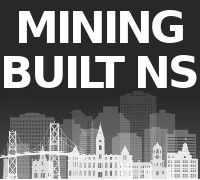- Why Mining Matters
- Jobs
- Safety
- Environment & Operations
- FAQ
- Links
- Fun Stuff
You are here

Thomas J. Brown
BESCO’s Pension
Dan McIsaac and Jim Taylor
Tius Tutty
Wilson Beaton
Aerotech Connector
Henry Swift
1885 Vale Tour
Douglas Slope Explosion
John Angus MacNeil and WWI
Florence Colliery
Joseph Walton
James Lennon
James Hamilton
1918 Allan Mine Disaster
Robert Boutilier’s Luck
Springhill’s John Anderson
Plight of Youth in 1931
Miners’ Wives Praised
Dominion No. 1B in 1931
Allan Shaft, 1931
Private Maceachern
Husseys Prospectus
William Routledge
Swell Factor in Reclamation
Gowrie Mine
River Hebert
Joggins 1904 Fire
Port Hood 1911 Flood
Lamp Cabin Memorial Park
Drummond 1873 Disaster
1872 Accidents
Springhill’s Novaco Mine
1860's Accident
New Glasgow's Linacy Mine
1913 Drummond Fires
1908 Princess Fire
Albion Mines 1913 Fire
DOSCO Miner
Cape Breton's TNT
The McCormick and Turner families
Payday Drunk
John Croak’s Victoria Cross
Atlantic Slag Company
Sydney Cement Company
1914 Coal Mine Cost
Dominion No 2
Canary in a Coal Mine
Draegermen
James Dinn
Pit Ponies
Henry Wadsworth Longfellow
1877 Accidents
Allan Shaft 1912
William Fleming
The Story of Peat
T. G. MacKenzie
Trenton Steel
1930 Stats
MacGregor Mine Explosion
MacGregor Flood
Torbanite Products Limited
Abraham Gesner and Kerosene
1860 Prince of Wales Visit
Dominion No 5
The Royal William and Stellarton Coal
Tom Pit
Terminal City
1875 Accidents
Cannons in Coal Mines
Princess Mine Explosion
Dominion No. 26
A Tale of Two Mines
Franklin Colliery
Robert J. Grant
Springhill No. 1
Mother Coo
Submarine Mines
Barrachois Mine
Fundy Coal Seam
Dominion #14
Dominion #12
Dominion No 4
Child Labour
Joggins Colliery
Safety
Bootleggers
Richmond County
Mabou Mines
Stellar Coal
English Slope
Maccan/Jubilee
The Foster Pit Fire and the Poop Solution
Thomas Edison and the Chignecto coal mine
Henry Whitney and the Dominion Coal Company
Foord Pit
Hiawatha Coal Mine
Coalburn
Springhill Disasters
St. Rose-Chimney Coalfield
Stellarton, Dorrington Softball Complex
How Does Coal Form?
Drummond Coal Mine
Sydney Coalfield and the Princess Mine
Port Morien, 1720
Port Hood
General Mining Association
Thorburn
WWII and Nova Scotia Coal
Nova Scotia's First Railway
Samuel Cunard
Stellarton’s Mining Connections
Sydney Mines
Point Aconi
Victoria Mines
Sullivan Creek
New Campbellton
Inverness and Cabot Links
The Ghost Town of Broughton
Tobin Road, Sydney Mines
Flint Island Coal Mine?!
What does Colliery mean?
Cottam Settlement
Allan Mine
BESCO’s Pension
BESCO took over most of Nova Scotia’s coal mines in 1920, kickstarting a turbulent, and sometimes violent, period in labour relations. Despite the company’s often-heartless attitude, it started a pension that helped many miners retire – but not out of compassion.
BESCO – the British Empire Steel Corporation – was formed through a merger of the Dominion Iron and Steel Company and the Nova Scotia Steel and Coal Company in 1920-21. The company was immediately a behemoth, controlling Nova Scotia’s steel production, most of its coal mines, the Halifax Shipyards and Newfoundland’s Wabana iron mines.
However, it also faced huge challenges. Demand for steel and coal dropped after World War One, and the company, with too little capital, needed to achieve unrealistic financial targets each year just to stay afloat.
In a desperate struggle to survive, the company’s management tried to cut costs by reducing miners’ wages and imposing other hardships on its employees, and tried to limit miners’ right to strike. This led to a series of strikes and confrontations with miners – a total of 58 in the Cape Breton coalfields alone between 1920 and 1925.
BESCO used its own security personnel, sometimes with support from the militia and police, to end strikes with force.
It was in this period that miner William Davis was shot and killed at the New Waterford Lake riot on June 11, 1925. Davis Day, still held each year on June 11, is a tradition that honours his death and those of other miners killed in Nova Scotia’s coal mines. It also acknowledges miners’ historical struggle for fair wages and better working conditions.
Today, Nova Scotia’s mining and quarrying industry is the highest-paying resource industry in Nova Scotia, with average total compensation of $102,000 per year. We are also one of the safer industries in the province. We have reduced our injury rate 90% since the Westray public inquiry report of 1997.
Labour challenges, shrinking steel and coal markets and millions in debt led to BESCO’s bankruptcy in 1927, and the Dominion Steel and Coal Corporation (Dosco) took over its assets.
In the midst of all these challenges, BESCO established a company pension fund in 1923 that helped older miners retire. However, this was not merely an act of kindness on the company’s part. Many company pensions in the late 1800s and early 1900s were attempts by companies to control their employees - to keep them loyal and reduce strikes, according to “A Brief History of Pensions in Canada,” by Unions for Public Good.
Nonetheless, a number of BESCO coal miners had retired by 1930 with the help of the pension.
According to the pension fund’s sixth annual report, between 1923 and 1930 it had paid out a total of $236,514 to retirees. The average years of service of the retirees was 41 and the average age on retirement was 70.
The total number of pensioners over those six years was 435. Of those, 106 pensions had been terminated due to deaths (104) and men who had returned to work (2).
The pension payments were based on years of service and 25 years of work at BESCO and its predecessor companies were required to be eligible. The average paid over the six years was $10.10 per month, but the average in 1929 was $35.35 per month. Three miners received the maximum pension payment of $75 per month that year, worth about $1350 per month in 2025 dollars.
The Evening Mail wrote, “The statistics given in the report…indicate the stamina, sturdy physique and general good health of the average Nova Scotia mine worker, with so many years being spent at the hard work of coal mining.”
The Evening Mail did a series of articles in 1930 that profiled some of the retired miners. Here are some of their stories:
Thomas Casey Sr. of Glace Bay was born in 1856 and started working at Glace Bay’s Caledonia mine in 1867. He worked there his entire career, starting as a trapper boy and rising all the way to underground manager. He retired in 1924 after 57 years of service.
Casey “has been one of the most respected citizens of the town,” according to the Evening Mail. “He has been a member of the board of St. Joseph’s hospital ever since the hospital was founded and several times in the early years of the town after incorporation he refused pressing requests to allow himself to be nominated for the town council. One of his sons, the late ‘Jack’ Casey, one of the most popular and successful mining men in Cape Breton, who died suddenly a few years ago, followed in his father’s footsteps by working up from a driver boy in Caledonia mine to become manager of the colliery.”
Hector McLean was born in Malagawatch in 1854. He went to work at the Bridgeport mine in 1873 and later worked at the Old Bridgeport mine, Dominion No. 1 and the No. 1-B until 1926 when he retired after 53 years of work. “His capability as a miner early won him promotion, and when pensioned he held the responsible position of deputy overman and examiner,” said the Evening Mail. “Mr. McLean is one of the ‘solid’ citizens of the town of Dominion, and served three terms in the town council. Three of his sons served in the Great War, one making the supreme sacrifice.”
Norman Robertson was born in Big Glace Bay in 1853, and started work there in 1868. He went on to work at coal mines in Schooner Cove, Lingan and Caledonia. He started working at the Dominion No. 6 mine when it opened in 1904 and worked there until he retired in 1926 after 57 years of service.
Thomas Stevenson was “one of the best type of old Cape Breton miners.” He was born in Newfoundland in 1856 but moved to Cape Breton where he started working at the Lingan mine in 1870. He went on to work in Victoria Mines and Reserve, where he retired in 1927 from his position as the mine’s examiner. “Notwithstanding his 57 years of service, Mr. Stevenson’s vigor and capability were such that the manager of the mine strongly protested against his being retired.”
Michael McMullin, born in 1843 in Castle Bay, worked from 1868 to 1924 at a long list of Cape Breton mines in Bridgeport, Blockhouse, Caledonia, Big Glace Bay and Bridgeport again. Next he went to Reserve, Lingan and back to Reserve where he remained until retirement after 56 years of work. “He was one of the first miners to be pensioned under the Besco pension scheme, but notwithstanding his 86 years is still ‘going strong.’”
Norman McRury was born in 1858 at Main-a-Dieu. He worked 56 years, first at Big Glace Bay and then at various other Glace Bay mines. His final job was as a rail car inspector with the Sydney and Louisbourg Railway. He retired in 1927. “Mr. McRury is well known and much respected all through the South Cape Breton mining district,” wrote the Evening Mail.
BESCO also owned mainland coal mines and some of the retirees featured by the Evening Mail were from Pictou and Cumberland counties. The Evening Mail reporter in Pictou County wrote that the retired miners from that county were “noted for their fine type of manhood.”
Daniel Gillis was born in Albert Mines, New Brunswick, in 1861. He started work in Stellarton at the age of eight in the Cage Pit and rose through the ranks to become manager of the Albion mine in 1912. He stepped down from that position in 1916 due to poor health, but continued working as building inspector and examiner until he retired in 1929 “with a splendid record of 60 years’ service.”
Alex B. McDonald of Stellarton, born in 1860, started working at nine years of age in the Dalhousie and Cage Pit mines. He worked in several other Pictou County mines, eventually serving the last 23 years of his career in the McGregor and Albion mines as overman, examiner and engineer. He retired in 1924 after 63 years of work.
“Few, if any, men have the long record of service that is to the credit of Abner McLean of Springhill,” wrote the Evening Mail. McLean was born in Boularderie, Cape Breton, in 1852. He started work at nine years old in the Lingan mine. He later worked in Cow Bay (now called Port Morien), Caledonia, Stellarton, Vale and Springhill. He retired in 1926 as an overman after 64 years of work. “D. H. McLean, district superintendent of the Cumberland mining district, is a son of this fine old Nova Scotia miner.”

















































































